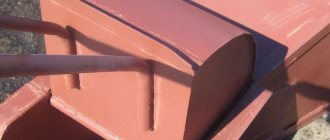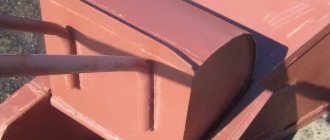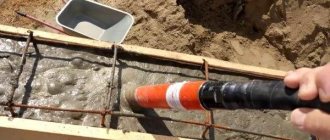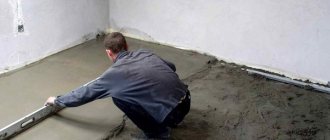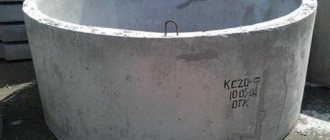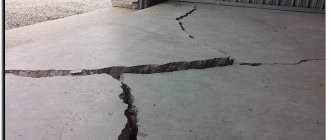Tips for builders | 11/21/2017
For a significant volume of monolithic work, the working composition of the concrete mixture is supplied to the places of direct use using special containers - concrete buckets. Their design is determined by the required intensity of concreting, ease of installation, as well as the duration of storage of the freshly prepared mixture.
How does concrete get into formwork?
One of the most critical stages in the construction of monolithic reinforced concrete structures is the delivery of concrete from the mortar-concrete unit to the place of its installation.
How concrete is delivered to the placement site Gone are the days when the concrete mixture was delivered to the construction site by dump trucks; now concrete is transported by domestic and imported concrete trucks of various capacities. Using this delivery method can significantly increase the life of concrete, since throughout the entire trip the mixing drum of the concrete truck rotates slowly (3 - 4 rpm), mixing the mixture, and almost fresh concrete arrives at the site. However, now the concrete mixture delivered to the construction site must be brought into place and poured into the formwork. Two main methods of supplying concrete are used here:• the traditional method: “crane-tub”, in which the concrete delivered to the construction site is poured into a rotating tub, laid in a horizontal position with the shutter closed. A construction crane turns the filled tub into a vertical position, lifts it and carries it to the place where it is poured into the formwork, where the shutter is opened and concrete is poured into the formwork;• a relatively new method of laying concrete using a concrete pump. In this case, the concrete mixture from a concrete truck is poured into the receiving hopper of a mobile (trailer) or truck-mounted concrete pump, which delivers the mixture directly into the formwork through concrete pipes. The power of modern concrete pumps allows the mixture to be supplied to a height of up to 100 m and a distance of up to 300 m. Both of these methods are used on domestic construction sites with equal success, and each of them has its own characteristics and, accordingly, areas of application.
Concrete pumps are high-performance modern equipment for laying concrete. Of course, the use of concrete pumps significantly reduces labor costs during concrete work, but its high productivity (up to 80 m³/hour) makes the use of such equipment economically justified only for significant volumes of concreting. At the same time, a situation may arise when it is necessary to concrete a structure to which the existing crane cannot supply concrete and it is necessary to either rent a crane with a long boom, which has a high lifting capacity with a large reach, in order to supply a bucket of concrete to this place, or use a concrete pump. In such a situation, a truck-mounted concrete pump can be used, which, thanks to a boom reaching a length of 60 m, can in a short time concrete a structure that is inaccessible to a construction crane of medium lifting capacity. For concreting large-area floors, mechanical or hydraulic mobile concrete dispensing booms are used, allowing the mixture to be supplied within a radius of 12 to 40 m from the boom installation point. At the same time, the use of concrete pumps has its own characteristics, in particular, the pumped concrete mixture should not contain aggregates with a fraction larger than 40 mm, in addition, the concrete must have a certain plasticity (cone slump) and it must be supplied continuously, otherwise the concrete pipes must be regularly cleaned of the mixture remaining on their walls. Despite these features, the use of concrete pumps significantly speeds up the process of laying concrete and allows concreting structures of significant volume in a limited time.
Which method should you choose? However, the “crane-tub” method, due to its simplicity and efficiency, is still successfully used on many construction sites, where the bulk of the construction is made up of structures with a relatively small volume, in particular multi-storey and individual residential buildings. For industrial construction or the construction of unique public centers or shopping complexes, it most often turns out to be economically justified to use a concrete pump. In any case, the method of supplying concrete, as well as the equipment and equipment necessary for this, must be selected at the stage of developing a concrete work project, taking into account economic and technological factors.
xn—-ptbbjegddbnkmk.xn--p1ai
Device requirements
Formwork diagram for the foundation.
In order for the supply of concrete mass during the construction of the foundation to be as uniform and homogeneous as possible, the gutters must meet certain requirements that apply to them:
The slope of the gutter must remain unchanged throughout the entire period of work during the construction of the foundation of the house. If this condition is not met and the angle of inclination, for example, decreases, then the speed of passage of the concrete mass will also decrease.
The angle of inclination of the gutter relative to the horizon must have a certain size, an increase in which will lead to the concrete mass being divided into parts. The reason for the change in the size of the angle of inclination may be the consistency of the concrete and the degree of its delivery distance.
Solutions of a more liquid consistency, supplied over a short distance, allow gentle slopes; for longer distances, steeper gutters are appropriate.
Kawabanga! Reinforced concrete frame
Purpose and design of the “Shoe” concrete bucket
There are two forms of container design: rectangular and cone-shaped. The first form is a “Shoe” tub for concrete, the second is a “Glass”. The shape of the “shoe” is a rectangle turning into a cone and really resembles this type of shoe. The hopper is loaded in a horizontal position with the shutter closed and fixed, and transported and used in a vertical position. Hence its additional name - rotary bunker. The rotation is made using lifting mechanisms.
This device opens at the bottom of the cone using a lever system, which provides regulation of the dose of concrete solution. In addition, the locking mechanism has a lock that prevents spontaneous opening. A folding chute serves to guide the pouring; To deliver the concrete mixture to hard-to-reach places, a rubberized hose is connected.
The handle for opening the hopper is offset and this allows you to visually control the concreting process. The design is stable in any position. If necessary, an electric vibration motor is installed on the “shoe”, in the area of the cone. Then the tub can be used for transporting rigid concrete and dry mixes. The advantage of this design is that the loading height in a horizontal position is low and it is possible to load concrete mortar from any type of concrete mixer.
Features of using the equipment
Before getting acquainted with the types of containers for supplying concrete, it is worth determining what they are needed for and the advantages of the equipment.
Concrete buckets are used:
- When unloading the solution from any type of transport, including a concrete mixer truck;
- When pouring the mixture into hard-to-reach places in the structure;
- To ensure the supply of trains when transport access to the unloading site is difficult;
- For work in small areas and the absence of a powerful crane, a concrete bucket is the best option.
The solution must be supplied to the container under certain conditions.
These include:
- Ability to carry out work at a relatively low speed;
- The need for equipment to lift the tub;
- Possibility of delivering the train to the loading site;
- Several workers must unload this bunker.
When doing monolithic construction with your own hands, such a container is not always needed - modern stationary concrete pumps easily supply the solution over hundreds of meters.
Even systems with smaller capacities mounted on a truck chassis can perfectly cope with delivering the composition to formworks located at a height of up to 30 meters. But the cost of such a process is quite high.
Manufacturing
The process of preparing the mortar is a labor-intensive construction operation. That is why the trough for preparing the batch should be highly durable and easy to use.
Let's consider one of the possible design options. For manufacturing you will need the following materials:
a metal sheet. It is advisable to use sheet steel measuring 1000x2000 mm, with a thickness of at least 1 mm, and having a zinc coating. The dimensions of the steel sheet may vary. The main thing is that the volume of the container corresponds to the assigned tasks;
Making a container for preparing a solution from sheet metal
- coniferous wood in the form of boards with a thickness of 30 to 50 millimeters. Prepare one board about 6 meters long, which will allow you to make a trough with dimensions of 1x2 m;
- nails for making a wooden frame or self-tapping screws for fixing steel sheets to boards.
When making a trough for concrete with your own hands, perform the work in the following sequence:
- Cut a solid six-meter board into 4 pieces: two pieces 2 meters long and two 1 meter long.
- Round the edges along the radius on two-meter workpieces, sawing off the corner fragments.
- Nail galvanized steel sheet to the straight parts of the prepared planks using nails.
- Bend the edges of the sheet at the level of the radius part and, using self-tapping screws, fix the meter-long boards.
- Additionally, secure the structural elements with self-tapping screws, which will increase the service life and ensure tightness.
Considering the small overall dimensions and weight, transporting such a container for concrete is not difficult. The radius shape of the sheet at the ends makes it easier to remove the finished solution and clean it. The tightness of the structure is achieved after the initial mixing, when the cement mortar seals small cracks. After the concrete mass hardens, water will not be able to flow out.
After the first batch, the trough will become almost airtight due to the filling of the cracks with concrete mortar
This design option is simple and allows the use of available building materials. Such a trough is a completely complete device for preparing concrete.
Materials, tools, procedure
The dimensions of the future product are taken based on the specific distances from the planned installation of the mixer or concrete mixer to the farthest point of the structure being poured.
In private low-rise housing construction, the length of the tray usually does not exceed 12 meters. The width of the tray is taken to be the “width” of a shovel plus 5 centimeters on each side (usually 300 millimeters), the height of the wall is the width of the existing edged board 150-200 millimeters.
The following materials and tools will be required:
- Edged board 25x150 or 25x200 of the maximum possible length for the tray box;
- Wooden block 40x40 or similar to strengthen the box;
- Wooden block 50x50 or similar for supports under the box;
- Galvanized or roofing iron for lining the bottom of the box;
- “Seventy”, “25”, “weaving” nails or wood screws;
- Hammer, wood saw, screwdriver, tape measure;
- Angle grinder with a metal disc or metal scissors. For cutting galvanized or roofing iron.
In order to save on expensive galvanized iron, you can independently plane the side of the boards along which the concrete will be transported as smoothly as possible. For these purposes you will need a plane or jointer.
Important! Some websites publish articles that suggest covering the bottom of the box with polyethylene or linoleum. This suggests that the authors have never made or used trays for concrete - polyethylene will very quickly be torn apart by filler and a shovel, and buying linoleum will be much more expensive than using iron or simply planing one side of the board.
Some features of the operation of construction devices
As noted above, it does not always make sense to purchase a bucket; sometimes it is much easier to rent one or even use the services of transporting concrete, since doing the work yourself will require too much effort.
This applies to many jobs, for example, cutting reinforced concrete with diamond wheels without special equipment will take too much time and money, and diamond drilling of holes in concrete is a completely impossible task without expensive devices. It is much easier to use the services of professionals who will carry out the work quickly and efficiently.
The paint must be periodically renewed, as the layer is severely damaged during use.
How does this happen
After the liquid solution has absorbed carbon dioxide, it becomes more porous. Because of this, moisture from the air easily penetrates into the frozen mass. As a result, lime appears in the concrete, which destroys the protective layer of the reinforcement (steel rods are pre-treated to ensure their inertness). Rust that occurs on reinforcement increases the volume of metal elements, which increases internal stress and destroys concrete products. After this, the corrosion process proceeds even faster.
The insidiousness of the process is that deep layers of concrete and iron reinforcement inside structures are subject to corrosion, which leads to rusting and subsequent rupture.
Concrete is a porous material that can retain moisture within its thickness. Therefore, the constant presence of water in the environment accelerates corrosion.
Determination of carbonation of concrete products
Laboratory experimental testing of products for resistance to carbonization is carried out by immersing samples in an alkaline solution for a certain time, after which they are split and the depth of the destructive effect is determined.
To determine defects on load-bearing structures and buildings, the phenolphthalein marker method is used. The indicator phenolphthalein, when in contact with areas where a lot of alkali has been released, acquires a pinkish or purple color.
Protection of concrete mixtures and structures from carbonization
To eliminate and prevent the problem, the following methods are used:
- Removal of defective layers.
- Padding.
- Treatment with sealing impregnations, paint and mastic coatings.
Concrete structures require constant control over the carbonization process of the material. This is especially important where they are exposed to aggressive factors. This applies to wastewater treatment plants, industrial enterprises, and residential buildings.
All road slabs are divided into two categories: for permanent and temporary use. As is clear from the purpose, the first slabs are much stronger and more durable, and therefore somewhat more expensive; they use stressed reinforcement.
Materials are traditionally cheaper in winter, since there is less demand for them. Due to the specific composition of concrete, it is not recommended to lay it at sub-zero air temperatures, since the material will not be able to gain strength.
The main task from the point of view of protecting concrete is to add water resistance to it. Here you can use various impregnation compositions.
Who said that concrete is a material that is only used for pouring foundations and floors? This material can be used to create stylish, functional, and most importantly, durable products for decorating your garden and site.
It is not at all necessary to make massive and heavy things from concrete, because it is good in small forms. Stylish little things in your garden - something you can do with your own hands.
Criterias of choice
From the description it follows that the simplest, therefore the most inexpensive, but quite capacious design are all types of “Boxes”. At the same time, the most convenient (from the point of view of transportation, loading and unloading and the ability to move bulk materials) tub is considered to be a rotating “Shoe”. “Ryumka” is recommended to be used in combination with small-scale mechanization equipment: chutes, concrete pumps and feed hoses.
In general, it makes sense to have at the construction site: a “Shoe”, a “Glass” and several “Boxes” of various capacities and designs, depending on the scale of the construction and the volume of planned concrete work.
Advantages and disadvantages of designs
Each model has its own characteristics, pros and cons. Some fixed-type models use both vertical and horizontal methods of loading concrete. At the bottom of the hopper there is a tray, it is usually made in the shape of a cone. Despite the identical dimensions, the pyramidal container is higher, but it is more difficult to clean the inner surface of solution residues.
In small designs, the bottom tray is most often opened manually. Large containers use locking connections.
Rotary models are more expensive, but also more comfortable to use. When using a “shoe”, supplying the solution requires fixing the structure at the desired angle to the support, this makes the work easier. It is possible to adjust the speed of supply of the mixture from the container. This type of design is more versatile, with increased convenience provided by the large cross-sectional area for the funnel.
Among the disadvantages of the “shoe”, it is worth noting the possibility of loading concrete only in a horizontal plane using two methods - using a dump truck or special vehicles. Thus, the “bell/glass” design is simpler and cheaper, while the “shoe” design is functional and comfortable, but costs more. The first option is suitable for small volumes of work, the second is relevant when performing large-scale fills.
A bucket for supplying concrete is a convenient and functional device that greatly simplifies and speeds up the pouring of concrete at sites. Provided the correct choice and professional operation, the bunker will serve for a long time and faithfully.
Types of submission
When transporting concrete mortar over a distance or height, it is necessary to maintain the technical characteristics of the material. In practice, 2 methods of movement are used to supply the mixture:
- Continuous technology. You can lift concrete to the immediate location using a hose, pipeline or conveyor-type machine. The method is used when the material is prepared at the installation site or when large-scale objects are being constructed.
- Cyclic transportation. The complex method consists of 2 stages. Initially, the cargo is delivered by a special vehicle - a mixer, a dump truck, a concrete truck, containers on watercraft or railway tanks. Further transfer is carried out through hoses and a pump directly for pouring into the formwork.
When constructing structures, a combined method of delivering concrete from the manufacturer to the installation site is used.
Criteria for choosing containers for concrete
To ensure optimal performance of construction work, compliance with technology, and ease of use of the container, a number of the following factors must be taken into account:
the dimensions must be suitable for carrying out all necessary manipulations in specific conditions; the capacity should be optimally compared with the scale of the concreting work, so as not to cause delays and to prevent idleness of the finished mixture; when choosing a shoe, you need to make sure that the required equipment can be used, the equipment is equipped, as well as the methods of attaching the sleeve or funnel; it is important that the lifting capacity is sufficient to ensure increased safety on the construction site, but taking into account the characteristics of the crane used; It is recommended to choose a branded manufacturer that guarantees high build quality, durability and reliability of the design (it is worth paying attention to Zitrek products).
Renting or buying?
- large amount of work;
- a tight or round-the-clock work schedule that does not allow downtime;
- it is necessary to make some changes to the scheme, for example, to strengthen the frame;
- are engaged in commercial activities and often perform work related to concreting: pouring sites or constructing multi-story monolithic buildings.
If you decide to buy a new tub, you will receive the following benefits:
- the design will fully meet the declared characteristics: absence of hidden or obvious defects, deformation of the container;
- it will be possible to maintain the ideal condition of the metal by ensuring gentle operating conditions and timely maintenance;
- loading the exact volume of solution, since there will be no dry concrete adhering to the walls.
Buying a used tub is an excellent alternative to purchasing a new one due to the following benefits:
- at the same price it will be possible to get larger container sizes;
- instead of a fixed shoe, choose the optimal shoe and improve work productivity;
- abandon Chinese equipment in favor of branded equipment, for example, Zitrek;
- operation at the maximum technical capabilities with minimal financial investments.
Used equipment that has been in use for a year has a cost that is 1.5-2 times lower than new equipment with similar characteristics. Therefore, from a financial point of view, it is the most profitable. The following risks are present:
- ideal external condition is the result of hiding critical defects, for example, rusted sheets or a supporting frame;
- inside steel structures, as a result of improper operating conditions, fatigue deformations have formed, which, under certain loads of the concrete mixture, partially or completely destroy the tub;
- There must be a technical passport.
In case of a limited budget or one-time concreting, renting is beneficial. Its cost depends on the service life of the equipment, its condition, design features and equipment. If there is a long distance to the construction site, then it is necessary to evaluate the possibility of purchasing, since sometimes transportation costs can make renting financially unprofitable.
Prices for new and used concrete buckets
| Type of service | Type | Volume | Load capacity, t | Dimensions, m | Price, rubles |
| Purchase (new) | Fixed with unloading tray and funnel clamp | 0,5 | 1,12 | 1.50x1.50x1.46 | 18900 |
| 1,5 | 3,75 | 1.52x1.52x2.00 | 29950 | ||
| Fixed with tray | 3 | 4,5 | 1.57x1.57x2.85 | 48800 | |
| Rotating with a platform for installing a vibrator | 1,6 | 4 | 3.60x1.60x0.89 | 36900 | |
| 2 | 5 | 3.70x2.10x1.14 | 45400 | ||
| Purchase (used) | Rotary | 0,5 | 1,12 | 3.1x1.27x0.7 | 15500 |
| 1,6 | 3,75 | 3.10x1.27x1.20 | 16000 | ||
| 2 | 4,00 | 3.60x1.27x1.34 | 19500 | ||
| Fixed | 0,5 | 1,25 | 1.25x1.25x1.27 | 10000 | |
| 0,75 | 1,88 | 1.25x1.25x1.68 | 14500 | ||
| 2 | 5 | 1.58x1.58x2.45 | from 19000 | ||
| Rent | Rotary | 1 | 2,5 | 3.17x1.27x0.72 | from 800 per day + 12000 deposit |
| 2 | 5 | 3.64x1.27x1.34 | |||
| Fixed | 0,5 | 1,5 | 1.25x1.25x1.27 | from 500 per day + 10,000 deposit | |
| 1 | 2,5 | 1.25x1.25x1.86 | |||
| 2 | 5 | 2.00x2.00x1.75 |
Models of concrete pumps in stock
| VIEW | Site size (METERS) / Price per shift / PRICE PER 1 HOUR (RUB) | NAME OF CONCRETE PUMP |
| feed height - 22 / 17 600 / 2 200 | M 22 | |
| 6*10 / 19 600 / 2 450 | M 32 | |
| 8*10 / 22 800 / 2 750 | M36 | |
| 8*10 / 32 000 / 4 000 | M42 | |
| 8*10 / 32 000 / 4 000 | M 43 | |
| 10*10 / 34 400 / 4 300 | M 46 | |
| 10*12 / 42 400 / 5 300 | M 52 | |
| 10*12 / 42 400 / 5 300 | M 53 | |
| boom feed height 57 m / 44,000 / 5,500 | M 57 | |
| Boom feed height - 62 m / 60,000 / 7,500 | M 57 |
Purpose and varieties
A tub may be needed when the volume of loading and unloading concrete is very large. When pouring monolithic foundations and other structures, the bunker makes it possible to significantly reduce the cost of delivering the finished mixture, eliminating the need for the services of a plant and providing the solution directly to the site. Ready concrete can be stored in the tub for some time.
Different models of buckets are suitable for implementing certain tasks, so before choosing, it is advisable to study the features of each option.
Glass or bell
This is a model of a fixed cylindrical tub with a cone. The bunker carries out vertical supply of concrete. The stability of the structure is achieved thanks to the presence of a support system in the format of wide rings. The rings are different, the configuration is different in the case of a filled and empty container.
The concrete solution is loaded into the bucket through the top from a dump truck. It's easiest to work with lowered models. The standard configuration assumes the presence of jaw-type locking connections, which are located in the lower part of the cone. Also, to simplify the supply of the solution, mechanisms are used: a trailed tray, a funnel, and fasteners for flexible hoses.
The “bell” model is used to load concrete mortar into similar/monolithic building structures. This type of tub is useful when working with very hard mixtures. Additional functionality is provided by replaceable trays and special hoses, without which concrete supply is only possible in one direction.
“Ryumka” is the simplest and most inexpensive version of a tub, the capacity varies in the range of 0.5-3 cubic meters (more can be found in Moscow, but rarely), the average carrying capacity is 2500 kilograms.
Tub in the shape of a shoe
This model is made with a rotating structure, the geometry of which can change. The capacity is 1-4 cubic meters, the hole for receiving concrete is rectangular, the mixture is unloaded horizontally, which guarantees comfort in operation and stability of the tub.
Externally, the model looks like a tapering and slightly truncated pyramid. The unloading funnel is closed with a special shutter, the body is reinforced with metal parts. The special frame provides additional protection and stability.
The main feature of the “shoe” model is the presence of a vibrator on either side of the tub, which significantly extends the life of the solution and allows it to be stored for a short time. The mixture becomes more homogeneous and active, and is easier to serve.
Cranes are used to move the tub and rotate it into a vertical plane. Thanks to the rotating type of design, the task is greatly simplified. This is a more functional model compared to the previous one. An important advantage is the connection of a vibrator, which does not allow concrete to linger on the walls of the container.
Discharge funnels in “shoe” type models can be very different – from slide to two-section. A system of levers initiates control. Using a bucket, concrete can be prepared directly on site.
Accessories for the tub
The designs, for ease of use, are equipped with a large number of parts, these are:
- loading hopper;
- valve;
- tray;
- gates;
- for control - handles;
- clamps;
- welded support frame;
- for attaching the tub with a tap - loops.
Bunkers are made in different sizes. Large-capacity tubs are made to order; there must be hanging cradles. So that workers sitting on them can easily control the supply of the finished solution.
Criteria for selecting buckets for supplying concrete
When purchasing a new product, pay attention to the following:
- For the desired capacity of the bunker: for buckets of the BN series it starts from 0.5 m3, for buckets of the BP series – from 1 m3. Volume gradation – every 0.2 m3.
- For the thickness of the metal of the bunker: rolled thin sheets will significantly reduce the service life of the product, taking into account the fairly high density of concrete mixtures and the operating conditions of the products at the construction site.
- On the quality of painting of all surfaces: the use of weather-resistant powder paints not only ensures the tightness of the coating in any atmospheric conditions (at least for a year), but also guarantees the durability of the equipment.
- For the presence of additional options in the design of the tub. In particular, the presence of a platform for installing a vibrator (for products such as a bell and a shoe) will speed up the process of unloading concrete and will reduce the complexity of subsequent cleaning of the internal surface of the bunker. For non-rotary versions, the convenience of unloading is also determined by the type of mechanism for opening the shutter jaws.
- Shape of transport eyes. It should be convenient for use when transporting the tub not only with cranes, but also with forklifts.
For periodic concrete work, buckets for pouring concrete are usually not purchased, but rented. The rented container must not have dents on the inner surface of the bunker, damage to the coating or defects in transport loops.
Concrete tray: where to start assembling?
Volumetric concrete work involves the use of the following machines and equipment: a truck mixer with ready-made concrete or a concrete mixer, a concrete pump or a tray for supplying concrete to the pouring area.
At the same time, a car mixer or a concrete mixer are “constant” quantities, that is, equipment that you cannot do without. An expensive concrete pump to rent (rental costs start from 14,500 rubles per shift) is usually replaced with a disposable wooden tray (in private housing construction), which can be disassembled and the boards used for other purposes.
Review of the most popular options and their advantages and disadvantages
As noted above, there are mainly two types of structures used, and you need to decide which one is suitable for a particular construction project
They differ in many characteristics, and it is important to choose the best option
Shot glass design
A bucket glass for concrete is one of the simplest types of products, which provides invaluable assistance in the process of work. But you need to understand that products of this type may differ from each other, and choosing a specific option can be difficult, even if you do not buy, but rent the device. After all, productivity and ease of use depend on the right decision.
It was the appearance that determined the name of the glass (some call this type a bell)
Let's consider what criteria you should pay special attention to, whether purchasing new equipment or used units:
The material used to make the product, most often steel, must be very durable. Insufficient thickness does not provide the required reliability
If you choose a used tub, then pay attention to the absence of damage; sometimes eliminating them will cost more than the product itself.
Also check other elements - each unit must be strong and reliable.
If you need a device with a capacity of 1 m3, you should not purchase an option twice as large: it is much heavier, and it will be inconvenient to work with.
A bucket for supplying concrete of this type consists of several main parts:
- The main container, made either simply in the shape of a cone, or as a cone with a cylinder on top. The features of this system depend on the required capacity.
- The support system is also of great importance; it can be of a wide variety of configurations. The main requirement for it is the strength and stability of both empty and full containers.
- A very important part of the design is the shutter with a handle with which the solution is unloaded; the shutter must be durable and the opening handle comfortable. (See also the article Cladding aerated concrete: how to do it.)
A comfortable valve handle is an important part of the design
Eyelets for attaching the structure to the crane and lifting it are very important, since the safety of everyone on the construction site directly depends on it.
Shoe type design
This is a more progressive option, but its price is noticeably higher; the requirements for strength and quality of materials for such structures are similar to those discussed above. (See also the article Concrete crushed stone: features.)
Instructions for checking the product yourself are as follows:
- First, all structural elements are carefully inspected for reliability and absence of damage.
- If the unit is used, then look inside the bunker: if it has not been cleaned, then a layer of hardened concrete can create a lot of problems for you.
Due to its external features, this type of design is called a shoe or galosh
This option has a number of advantages:
- The design of the product is rotary, which allows you to adjust the direction of unloading concrete and increases the ease of use of the bucket. It is this advantage that determines the popularity of this type of product.
- The structure may have a platform for installing a vibrator, which significantly speeds up the unloading process and prevents concrete from sticking to the walls.
- Another undoubted advantage is the ability to load the solution both from a mixer and from a dump truck; this can simplify the work and reduce the cost, since special transport is much more expensive than conventional trucks.
- Despite the large capacity and reliability of the products, their unloaded weight is relatively small, which increases ease of transportation.
- Loading such containers is much easier, since this is done with the tub in a horizontal position (transportation is carried out in a vertical position).
Convenience of loading the container is another important advantage
Cubel, portable bunker or tub for concrete mixture.
Now everyone knows that any housing for a person is not a natural derivative, grown in a garden or in the forest, but the result of human creative activity and his desire for improved comfort, coziness and preservation of the indoor microclimate.
Housing for us is not only a place where we sleep, eat, relax and spend most of our time with our children. Housing is our world, which is created by us and for us. A world that is understandable only to its creator and which has its own law, its own morality, which has its own atmosphere of relationships and understanding.
You must admit that it is not easy for a person living in an apartment building to establish relationships with restless neighbors or with the other residents of the same entrance, who often “muddy” the established atmosphere. For us, an apartment is the same house, albeit an imaginary one. (I’m going home. At my house. I came home. But I live in an apartment.)
Anyone who moves to a separate plot of land, purchased or inherited, gets a real home – it doesn’t matter. Some people like the house they live in, others don’t like it and remodel it in their own way. And someone, using their capital, builds their own masterpiece, attracting friends, relatives or third-party construction organizations that use advanced technologies in their construction.
And sometimes, having received good practice and extensive technological experience, the developer organizes his own enterprise to provide construction services. Hires workers, purchases equipment and construction equipment, among which mortar containers and bunkers for delivering concrete mixtures occupy an important place during large-scale construction.

